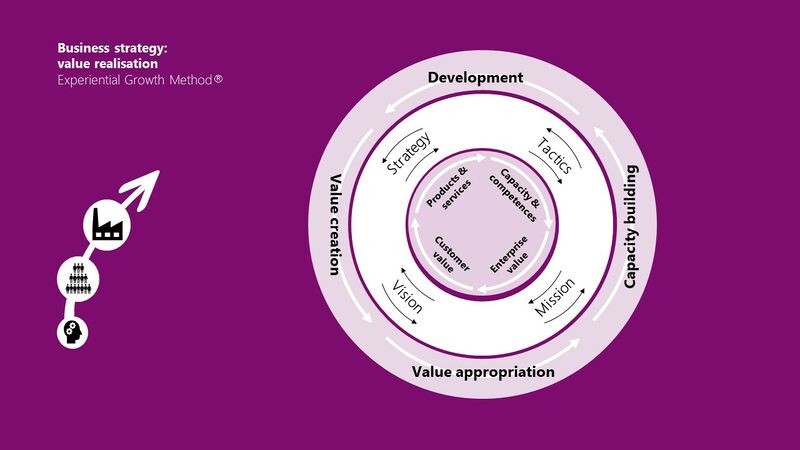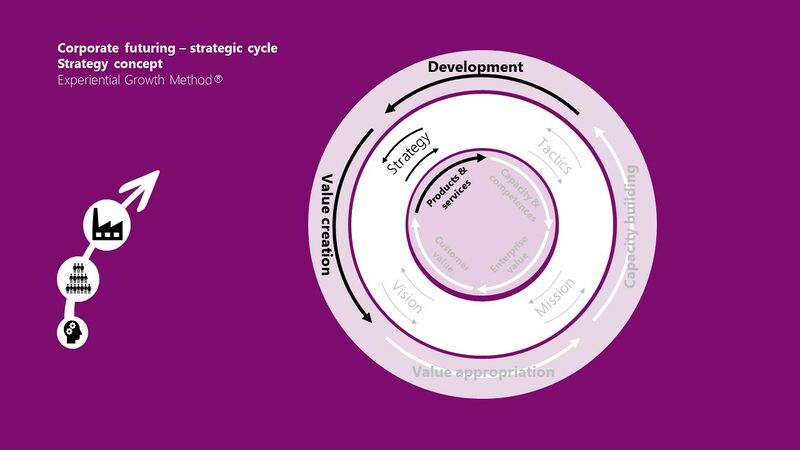Strategic cycle
Chapter 4 - Corporate futuring
Previous page: Emerging results - Strategic cycle - Next page: Strategic cycle: vision
Back to Book content or directly to Main Page
.
Welcome to the Strategic cycle page
.
Introducing the (triple) strategic cycle: a generic view on your value realisation
.
Strategy is about value realisation.
We present you with a metaphor beyond the 'scale', but as opposing dynamical cyclical movements.
- First of all, it is not a specific moment in time. Strategy is dynamic and constantly present.
- Secondly, it isn't a walk in the park. Two forces constantly fight each other.
- your inner focus (the inner circle, running clockwise on the picture)
- and your outer focus (The outer circle, running anti-clockwise on the picture)
- In between, the strategic cycle (vision, strategy, tactics, mission) tries to balance those two forces.
To succeed in this, each part of the cycle (vision, strategy, tactics and mission) has to unite these opposing forces and, at the same time, connect with the next step in the process.
.
Outer circle
Outside-in focus (ANTI-CLOCKWISE)
- The outer circle is about action and doing, driven by every possible stakeholder 'in the current situation'.
- It is about the stress-sensitive situations for your company.
.
Inner circle
Inside-out focus (CLOCKWISE)
- The inner focus circle is about focusing on what is essential for the long-term survival of your firm.
- So what has to be authentic and suitable?
.
Middle circle
The driver of the strategic cycle (BI-DIRECTIONAL)
Between the inner focus- and the outer focus circles lies your strategic cycle.
- it has, on the one hand, a comprehensive sensitivity to absorb external signals
- and on the other hand the ability to maintain the internal focus.
.
The four-step strategic cycle pattern
The natural sequence (of human-based processes) is:
- Dream
- about the value you can offer to your customers
- Analyse
- which products and/or services you have to deliver
- Decide
- what you can provide by the competencies in and capacities of your enterprise
- Do
- what is suitable, affortable & faisable
.
At your strategic level, this corresponds to the following 4 strategic cycle steps. They consist of:
- Vision
- Customer value (Inside)
- Value creation (Outside)
- Value appropriation (Outside)
- Customer value (Inside)
- Strategy
- Product & services (Inside)
- Development (Outside)
- Value creation (Outside)
- Product & services (Inside)
- Tactics
- Capacity & capabilities/competences (Inside)
- Capacity building (Outside)
- Development (Outside)
- Capacity & capabilities/competences (Inside)
- Mission
- Enterprise value (Inside)
- Value appropriation (Outside)
- Capacity building (Outside)
- Enterprise value (Inside)
.
Dive deeper
.
What is happening in the enterprise vis-à-vis the context you are in?
.
.
- The elements of the outer circle are all about your company's market situation, the relationship with its stakeholders, clients, employees, shareholders, etc.
The dynamics of the outer circle (ANTI-CLOCKWISE)
- (Start) Enterprise value (from the inside circle).
- Capacity building
- The enterprise value must be shared between (or supplemented by) the shareholders and the organisation's members. Which resources to we reserve so the enterprise can start building its capacity?
- (Organisational) Development
- Good products and services can only be developed and/or delivered if the enterprice has the correct standards. How do we manage the development of the entire organisation?
- Value creation
- Good products & services are not enough. How do we ensure value creation for our customers?
- Value appropriation
- The value we create for our customers, they convert into (financial) value for us. Customer value is converted in this step: value appropriation from customer value to enterprise value. The cycle starts again ...
.
.
What is happening inside your enterprise?
.
.
- The elements of the inner circle are all about your company's financial situation, tangible and intangible resources, employees' capabilities, the quality level of the products & services, etc.
The dynamics of the inner circle (CLOCKWISE)
- (Start) Customer value
- What value do we want to deliver to our customers?
- Products & services
- What sort of products and/or services do we create to deliver value?
- Capabilities/competences (& its capacities)
- By rolling out products and services, which (extra) capabilities/competencies (& capacities) do we need?
- Enterprise value
- How do we create enterprise value by deploying the available capacities and competencies?
- (Restart) Customer value
- Enterprise value allows us to deploy resources to create customer value: the cycle starts again ...
.
.
The gear wheel between the former two is your strategic path
.
.
- As you have noticed, the inner and outer circles turn in opposite directions. This is because they have a natural opposite momentum.
- Vision, strategy, tactics and mission act like gears to keep the inner and outer circle at the right pace.
- The dynamics of the middle circle ( BI-DIRECTIONAL), creating the strategic cycle.
.
.
'The Corporate futuring strategy concept' is relational and consists of the following four elements (within the context you are in):
.
The 4 strategic steps in detail
Vision
.
- An inspirational description of what your organisation would like to achieve or accomplish in the mid-term or long-term future.
- Your company's vision has to be able to:
- create customer value,
- and at the same time, enhance value creation while, streamlining value appropriation.
.
.
Strategy
.
- Planning and marshalling present and new resources for their most efficient and effective use.
- Your company's strategy has to be able to:
- produce the right products & services,
- and at the same time, develop the business while, creating value for all stakeholders.
.
.
Tactics
.
- Planned and ad hoc activities meant to deal with the demands of the moment and move from one milestone to another.
- Your company's tactics have to be able to:
- grow capacity and capabilities/competencies,
- and at the same time, building capacity while supporting the enterprise development.
.
.
Mission
.
- Specific tasks with which a person, a group or your company as a whole is charged.
- Your company's mission has to:
- create enterprise value
- and at the same time, appropriate value while being able to invest in business capabilities.
.
.
The mindset of working on value realisation
We now know the elements and the dynamics of value realisation.
- Unfortunately, organisations and companies usually invest most of their energy in one or maximum two steps of the strategic process.
- For example, focusing on the mission statement and working on tactics to realise the mission. And than it stops.
- Or, working on the strategy to realise the great vison of the founder. And than it stops.
- Or, ...
You can image examples for yourself.
.







